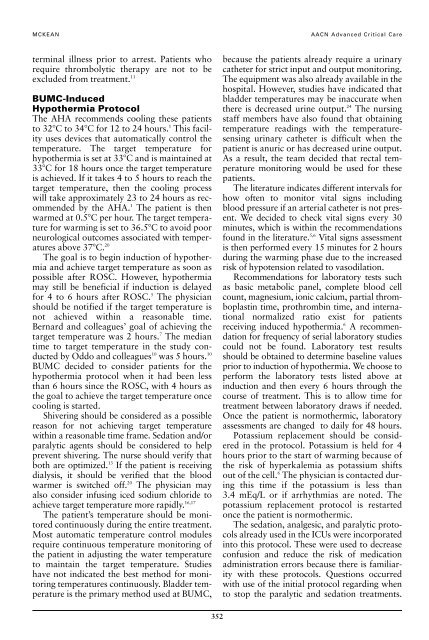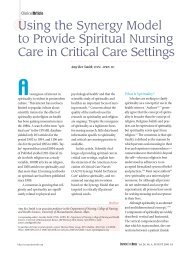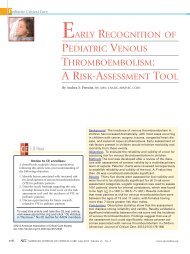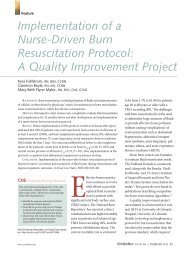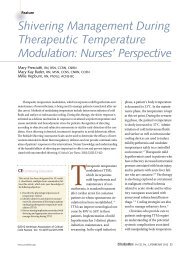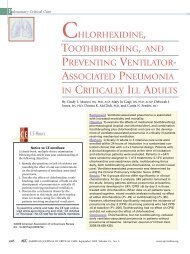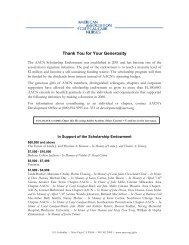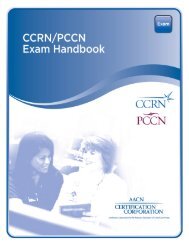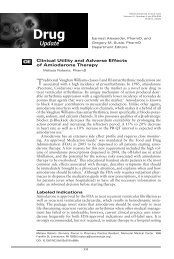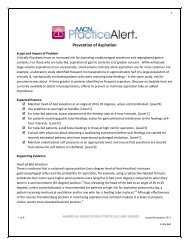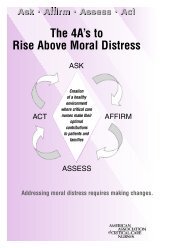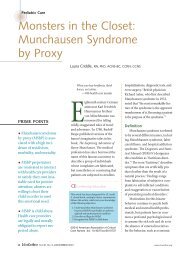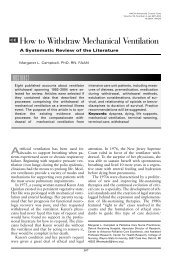Induced Moderate Hypothermia After Cardiac Arrest - American ...
Induced Moderate Hypothermia After Cardiac Arrest - American ...
Induced Moderate Hypothermia After Cardiac Arrest - American ...
Create successful ePaper yourself
Turn your PDF publications into a flip-book with our unique Google optimized e-Paper software.
MCKEAN<br />
AACN Advanced Critical Care<br />
terminal illness prior to arrest. Patients who<br />
require thrombolytic therapy are not to be<br />
excluded from treatment. 11<br />
BUMC-<strong>Induced</strong><br />
<strong>Hypothermia</strong> Protocol<br />
The AHA recommends cooling these patients<br />
to 32C to 34C for 12 to 24 hours. 1 This facility<br />
uses devices that automatically control the<br />
temperature. The target temperature for<br />
hypothermia is set at 33C and is maintained at<br />
33C for 18 hours once the target temperature<br />
is achieved. If it takes 4 to 5 hours to reach the<br />
target temperature, then the cooling process<br />
will take approximately 23 to 24 hours as recommended<br />
by the AHA. 1 The patient is then<br />
warmed at 0.5C per hour. The target temperature<br />
for warming is set to 36.5C to avoid poor<br />
neurological outcomes associated with temperatures<br />
above 37C. 20<br />
The goal is to begin induction of hypothermia<br />
and achieve target temperature as soon as<br />
possible after ROSC. However, hypothermia<br />
may still be beneficial if induction is delayed<br />
for 4 to 6 hours after ROSC. 5 The physician<br />
should be notified if the target temperature is<br />
not achieved within a reasonable time.<br />
Bernard and colleagues’ goal of achieving the<br />
target temperature was 2 hours. 7 The median<br />
time to target temperature in the study conducted<br />
by Oddo and colleagues 10 was 5 hours. 10<br />
BUMC decided to consider patients for the<br />
hypothermia protocol when it had been less<br />
than 6 hours since the ROSC, with 4 hours as<br />
the goal to achieve the target temperature once<br />
cooling is started.<br />
Shivering should be considered as a possible<br />
reason for not achieving target temperature<br />
within a reasonable time frame. Sedation and/or<br />
paralytic agents should be considered to help<br />
prevent shivering. The nurse should verify that<br />
both are optimized. 13 If the patient is receiving<br />
dialysis, it should be verified that the blood<br />
warmer is switched off. 20 The physician may<br />
also consider infusing iced sodium chloride to<br />
achieve target temperature more rapidly. 16,17<br />
The patient’s temperature should be monitored<br />
continuously during the entire treatment.<br />
Most automatic temperature control modules<br />
require continuous temperature monitoring of<br />
the patient in adjusting the water temperature<br />
to maintain the target temperature. Studies<br />
have not indicated the best method for monitoring<br />
temperatures continuously. Bladder temperature<br />
is the primary method used at BUMC,<br />
because the patients already require a urinary<br />
catheter for strict input and output monitoring.<br />
The equipment was also already available in the<br />
hospital. However, studies have indicated that<br />
bladder temperatures may be inaccurate when<br />
there is decreased urine output. 24 The nursing<br />
staff members have also found that obtaining<br />
temperature readings with the temperaturesensing<br />
urinary catheter is difficult when the<br />
patient is anuric or has decreased urine output.<br />
As a result, the team decided that rectal temperature<br />
monitoring would be used for these<br />
patients.<br />
The literature indicates different intervals for<br />
how often to monitor vital signs including<br />
blood pressure if an arterial catheter is not present.<br />
We decided to check vital signs every 30<br />
minutes, which is within the recommendations<br />
found in the literature. 5,6 Vital signs assessment<br />
is then performed every 15 minutes for 2 hours<br />
during the warming phase due to the increased<br />
risk of hypotension related to vasodilation.<br />
Recommendations for laboratory tests such<br />
as basic metabolic panel, complete blood cell<br />
count, magnesium, ionic calcium, partial thromboplastin<br />
time, prothrombin time, and international<br />
normalized ratio exist for patients<br />
receiving induced hypothermia. 6 A recommendation<br />
for frequency of serial laboratory studies<br />
could not be found. Laboratory test results<br />
should be obtained to determine baseline values<br />
prior to induction of hypothermia. We choose to<br />
perform the laboratory tests listed above at<br />
induction and then every 6 hours through the<br />
course of treatment. This is to allow time for<br />
treatment between laboratory draws if needed.<br />
Once the patient is normothermic, laboratory<br />
assessments are changed to daily for 48 hours.<br />
Potassium replacement should be considered<br />
in the protocol. Potassium is held for 4<br />
hours prior to the start of warming because of<br />
the risk of hyperkalemia as potassium shifts<br />
out of the cell. 6 The physician is contacted during<br />
this time if the potassium is less than<br />
3.4 mEq/L or if arrhythmias are noted. The<br />
potassium replacement protocol is restarted<br />
once the patient is normothermic.<br />
The sedation, analgesic, and paralytic protocols<br />
already used in the ICUs were incorporated<br />
into this protocol. These were used to decrease<br />
confusion and reduce the risk of medication<br />
administration errors because there is familiarity<br />
with these protocols. Questions occurred<br />
with use of the initial protocol regarding when<br />
to stop the paralytic and sedation treatments.<br />
352


